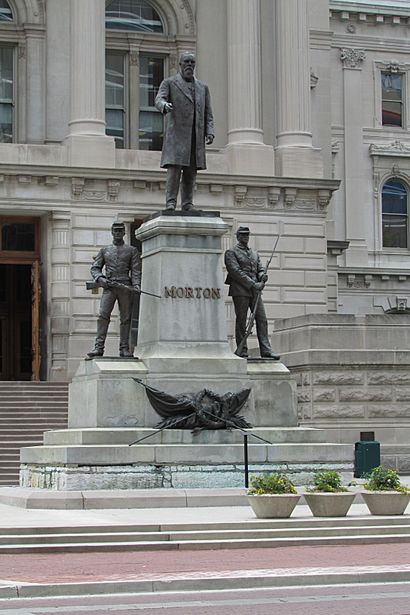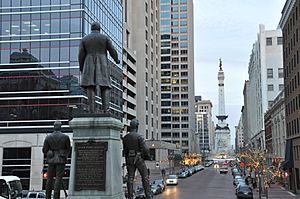Oliver P. Morton (monument) facts for kids
Oliver P. Morton and Reliefs is a public artwork created by Austrian artist Rudolph Schwarz. You can find it on the east side of the Indiana Statehouse in Indianapolis, Indiana. It's located where North Capitol Avenue and West Market Street meet.
Contents
About the Morton Memorial
The Oliver P. Morton memorial features three bronze statues and two bronze reliefs. A relief is a type of sculpture where figures are raised from a flat background. The memorial also has three bronze plaques. The statues stand on pedestals made of granite.
Statues and Their Details
Oliver Perry Morton stands in the center, taller than the other two figures. Two Union soldiers stand on either side of Morton. The soldier on the left wears a uniform and holds a bayonet. The soldier on the right also wears a uniform and holds a rifle, with a sword on his left side.
At the base of the pedestals, you'll see two crossed flags with olive branches. In the middle, there's an oak wreath made of leaves and acorns.
Bronze Reliefs and Plaques
The two bronze reliefs are on the sides of the soldiers' pedestals. The relief facing south shows Oliver P. Morton giving a speech. The relief facing north shows him standing inside a hospital tent.
On the back of the memorial, there are two bronze plaques. The top plaque is on Morton's pedestal. It tells you about his life:
Oliver Perry Morton
Born in Wayne Co. Indiana August 4, 1823.
Died in Indianapolis November 1, 1877.
Aged 54 years 2 months and 25 days.
Admitted to the Bar in 1847.
Served as Governor of Indiana from January 18, 1861 to March 4, 1867.
Served as U.S. Senator from Indiana from March 4, 1867 until his death November 1, 1877.
In all ways and at all times the friend of the Union soldier. The friend of the country.
The upholder of Abraham Lincoln.
The defender of the flag and the Union of the States. Patriot. Statesman.
Lover of Liberty. Heroic in heart.
Inflexible in purpose and ever to be known in history as
The Great War Governor
The plaque below the first one, on the lower part of the pedestal, explains who commissioned the memorial:
The annual meeting held in June, 1904, The Department of Indiana.
Grand Army of the Republic.
An organization of the honorably discharged soldier and sailors who served in the Army and Navy to preserve the integrity of the Republic of the United States of America, in the Great Civil War from A.D. 1861 to 1865, memorialized the legislature of the State of Indiana to appropriate sufficient money to erect this monument to perpetuate the memory of
Oliver Perry Morton
The Great War Governor of Indiana during that period.
History of the Monument
This memorial was put in place in 1907. The Indiana General Assembly (Indiana's law-making body) asked for it to be built.
Planning and Design
Planning for the Morton memorial started in early 1906. On February 9, 1906, a special commission met. Artists presented their designs for the bronze figures and plaques. Rudolph Schwarz from Indianapolis was one of the artists.
The commission chose designs by John R. Lowe for the pedestals. After advertising in newspapers, bids for the pedestals were received on April 10, 1906. Chas. G. Blake & Co. from Chicago, Illinois, won the bid to build the pedestals.
Construction and Materials
Soon after, the area for the memorial was named "Morton Plaza." The pedestals were made larger, and the contractors received extra payment for this change. On June 4, 1906, Rudolph Schwarz signed a contract to create parts of the memorial. This included the name "Morton," a plaque about Governor Morton's life, a plaque for the Grand Army, and the two ten-foot-tall bronze statues of Civil War soldiers.
Two decorative railings, called balustrades, were added to the north and south ends of Morton Plaza. Rudolph Schwarz also received another contract to create two bronze bas-reliefs for these balustrades. A bas-relief is a type of relief sculpture that is not very deep.
The bas-relief on the south balustrade honors the women of the war. It describes how they helped by providing clothing and hospital supplies, and by nursing the sick and wounded. The north bas-relief shows a scene of soldiers returning home from the war.
The foundation for the pedestals is made of solid limestone and cement. The pedestal itself weighs 32 tons. It took 16 horses to move it into place. The bronze used for the monument weighs about 16,000 pounds. About 8,000 pounds of that is just for the Morton figure. The bronze is mostly copper, with some tin and zinc.
Unveiling and Completion
Oliver Perry Throck Morton, who was Morton's grandson, unveiled the memorial when he was 8 years old. After the dedication, the only thing left to do was pave the plaza. Crushed granite and granite steps were installed soon after. The total cost for the project was $36,544.40.
Who Was Oliver Perry Morton?
Oliver Perry Morton was the first governor of Indiana who was born in the state. He was born in Salisbury, Indiana, in Wayne County. His family's original name was Throckmorton.
Early Life and Education
When he was young, Oliver worked as a hatter's apprentice for four years. After that, he went to college at Miami University in Ohio. He then studied law in Centerville, Indiana and at law school in Cincinnati, Ohio. Morton started his legal career by studying law in Judge Newman's office in Centerville.
Political Career
Morton first belonged to the Democratic Party. He was against the spread of slavery. Later, he helped start the Republican Party. In 1856, he was one of three people from Indiana who went to the Republican Party's first big meeting in Pittsburgh.
In 1856, his new party nominated him to be governor of Indiana. In 1860, he was elected lieutenant governor alongside Henry S. Lane. He became governor when Lane was elected to the United States Senate. Morton was re-elected governor in 1864 and served until 1867. Then, he was elected to the United States Senate.
He was re-elected to the Senate in 1873. As a Senator, he worked to pass the Fifteenth Amendment, which gave African American men the right to vote. He was also involved in the impeachment (a process to remove a public official from office) of President Andrew Johnson. Morton was a trusted advisor to Republicans in the South. At the national Republican convention in 1876, he received many votes for president. He was known as a leading Radical Republican during his time in government. He passed away on November 1, 1877.
About the Artist: Rudolph Schwarz
Rudolph Schwarz (June 1840 – 14 April 1912) was a sculptor from Austria. He moved to Indianapolis in December 1897. He came to help finish the Soldiers' and Sailors' Monument in Indianapolis, Indiana.



